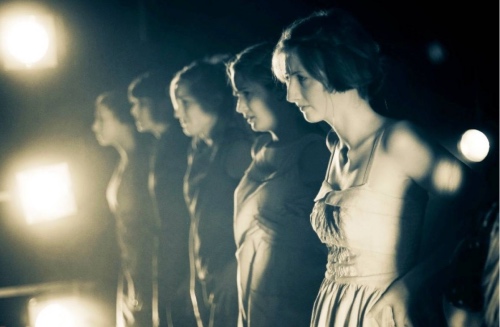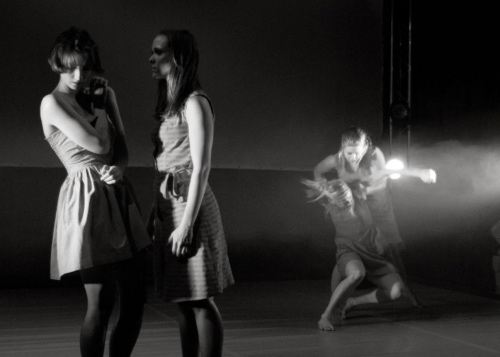
KIERAN GUILBERT, of the Thomson Reuters Foundation, reports from London on initiatives to help educate the public about the issue of slavery as well as supporting survivors…
Grabbed, groped and thrown to the ground, the young woman adopts the foetal position as the four female attackers loom over her.
Dragged, kicked and strangled, the woman goes limp, drawing gasps from the audience as she lies lifeless on the stage.
For the victim and her abusers are in fact performers, using theatre and dance to shock their spectators and throw a spotlight on modern slavery in Britain, while also helping survivors to regain their confidence through dancing.
“Art is a very powerful way of speaking out about the issue,” Erena Bordon Sanchez, founding director of The Natashas Project, a modern dance and theatre company set up in 2013, told the Thomson Reuters Foundation after a recent show in London.


A “POWERFUL WAY OF SPEAKING OUT”: Top – Dancers during a physical theatre performance about modern slavery in London; and Below – Dancers enact a scene of violence during a physical theatre performance about modern slavery. PICTURES: The Natashas Prject/Handout via Thomson Reuters Foundation.
“Our aim is to connect with the public, by portraying through dance what people might experience during slavery.”
– Erena Bordon Sanchez, founding director of The Natashas Project.
While modern slavery is increasingly capturing the attention of the media worldwide, few in Britain have grasped the scale of a crime estimated to trap at least 13,000 people in the country in forced labour, sexual exploitation and domestic servitude.
One in five people in Britain have never heard of modern-day slavery, and more than half say they wouldn’t know what to do, or who to talk to, if they suspected that someone was a victim, according to a poll in October by British supermarket Co-op.
“Our aim is to connect with the public, by portraying through dance what people might experience during slavery,” said Ms Sanchez, whose company also visits schools and youth groups to talk to young people about the drivers and signs of slavery.
On top of their performances and educational visits, The Natashas Project also holds dance sessions at shelters for survivors of domestic abuse, sexual violence and slavery.
“We don’t see it as therapy,” Ms Sanchez said. “It’s about creating a community, having fun and building up confidence.”
For some women staying in shelters – abused, battered and broken – dancing offers respite from the horrors they have endured and the stress and uncertainty around their future.
“Many of these women have suffered from the destruction of their sense of self, and their own worth,” said Charlotte Desorgher, project director at the Company of Dreams, a dance group that offers free belly dance classes for women in refuges.
“We need to give them some fun,” she said. “A giggle, some music and a dance is very powerful – it can lift the spirits.”
Yet dance classes can do more than just boost self-esteem.
“A lot of the women say the classes have saved their lives, often those who have been abused or raped,” Ms Desorgher added.
While there is no solid data on survivors of slavery in Britain, at least 3,800 possible victims were referred to the government last year. About half were women and girls and many came from countries such as Albania, Vietnam and Nigeria.
These people are placed in safe houses and given help ranging from legal aid to counselling while the government decides whether to class them as victims of slavery – meaning that they may be allowed to remain in Britain in the short-term.
Activities including arts and crafts, dancing and gardening provide a welcome distraction, and a creative outlet, to such people living in limbo, said Anne Read of the Salvation Army.
“Victims in safe houses often don’t want to talk about their experiences, or engage with counselling services,” she said.
“Art, dancing, gardening…they offer people another way to express themselves, to overcome the language barrier,” added Read, the charity’s head of anti-trafficking and modern slavery.
While no survivors of slavery wanted to be interviewed in person or over the phone by the Thomson Reuters Foundation – for personal and safety reasons – two women were willing to share over email their thoughts about a recent dance session.
“I feel free, love, happy, confidence,” said one, aged 39.
The other woman said she enjoys “every bit” of the classes.
“It’s amazing to have wonderful people … making us feel loved and belonged despite all the challenges we face each day.”





